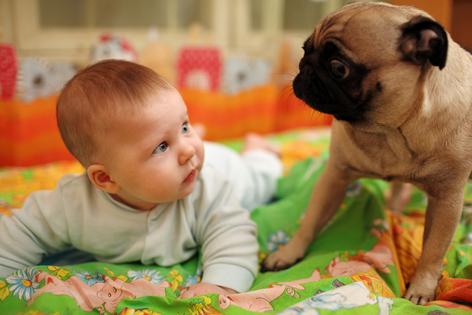My Pet World: No rivalry here — Helping dogs see baby’s arrival as a blessing
Dear Cathy,
My son and daughter-in-law welcomed a new baby to their family. They’re living with us right now as they’re having construction work done on their house. They should be moving back into their own home soon.
Their Pug, who was their “baby” for six years, is having a hard time adjusting. When the baby cries, she barks uncontrollably. When my son or daughter-in-law go to pick up the baby, the barking and jumping is worse. We’ve tried distraction and rewarding good behavior, but it doesn’t seem to be working. We’ve started moving her into a different room, enticing her with a toy or treats. I know these are a lot of changes for a dog to deal with. Do you have any suggestions for us to help her adjust?
— Terri, Long Island, New York
Dear Terry,
For many dogs, a new baby in the family can feel like a mixed blessing. While the parents are overjoyed, the dog may wonder what happened to all the attention and playtime she used to enjoy. How you handle those early days makes a big difference in whether she views the baby as a rival – or as a new best friend.
It’s important to avoid creating an unintentional negative association where the dog feels excluded whenever the baby is present. For example, if the dog is routinely sent to another room when the baby comes in, her first impression becomes: When the baby is around, I get kicked out. Over time, that can foster resentment towards this new family member.
Some families also may give the dog extra attention when the baby goes down for a nap, thinking, Now I finally have time for the dog. But this can also backfire, as the dog may start to associate the baby with a lack of attention and see nap time as the only moment she feels noticed and cared for. That pattern sets the stage for the dog to view the baby’s presence negatively.
To prevent problems, encourage your family to give their dog positive attention whenever the baby is present. That can mean offering treats, giving praise, tossing a ball while you sit with the baby, or taking her on walks with the baby in the stroller. The idea is to make the dog view the baby’s presence as the start of fun activities rather than competition for attention.
If the new parents need time with the baby without the dog, don’t banish her from another room. Instead, give her an engaging puzzle toy or chew, so she can remain nearby, happily occupied, while the baby is the focus. While moving her out of the room during overstimulating moments may sometimes be necessary, avoid relying on it too often. Otherwise, she may come to associate the baby with being excluded. The goal is for her to learn that when the baby is awake and nearby, good things happen for her too.
Teaching basic commands like “sit” or “place” also helps manage barking and jumping, and these can be practiced even while holding the baby. What better way to get her used to this new little person than to practice commands and give treats with the baby in their arms?
When the baby naps, casual interaction is fine, but save the enthusiastic praise, play, and special treats for when the baby is present. Then, when the baby wakes, tell them to get excited and invite the dog to join them in the baby’s room. Over time, she will begin to look forward to the baby being around and a part of her world.
Dear Cathy,
I just read the column about the overly friendly cat. This cat needs a feline companion. The need for attention, companionship, and activity seems to be too much for his owners but is just right for a companion animal.
— Anita, West Hartford, Connecticut
Dear Anita,
You’re right that some cats do benefit greatly from having a feline companion, especially when their need for attention and play feels overwhelming for their people. A well-matched companion can help share the energy load, provide constant entertainment, and give the first cat a buddy to wrestle, groom, and curl up with.
That said, not every cat enjoys living with another cat, so owners need to consider their pet’s temperament and be prepared for a proper introduction process. For some cats, interactive toys, puzzle feeders, and dedicated playtime with their humans may satisfy those social needs just as well.
Still, you raise an important point: Sometimes the best gift we can give a cat who craves more interaction is a compatible feline friend.
_____
_____
========
(Cathy M. Rosenthal is a longtime animal advocate, author, columnist and pet expert who has more than 25 years in the animal welfare field. Send your pet questions, stories and tips to cathy@petpundit.com. Please include your name, city, and state. You can follow her @cathymrosenthal.)
©2025 Tribune Content Agency, LLC.
(c) 2025 DISTRIBUTED BY TRIBUNE MEDIA SERVICES, INC.












Comments